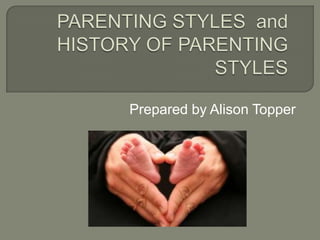
History of the study of child development
- 1. Prepared by Alison Topper
- 2. Is complicated! Parent needs to know when to back off and let child do for himself… Needs to avoid pushing children to do things they aren‟t ready for Need to let child fail as they learn And skills change…
- 3. Authoritarian: • Children should obey their parents Without question • Parent tells the child what to do, and the child‟s duty is to do it • When rules are broken, the authoritarian parent acts quickly and firmly
- 4. Authoritative or Democratic: • Parents are still in charge Children have more input into rules and limits • Children are given more independence and choice within the less structured rules.
- 5. Permissive: • Children are free to set their own rules. • Parents grant a wide range of freedom
- 6. The styles overlap! A parent is usually not always in one style all the time.
- 7. 1. Parent must meet the basic needs of a child • Provide food, clothing and shelter • Monitor safety and health • Teach language skills • Provide opportunity for learning through school • Teach the children to get along in social groups • Provide opportunity for the child to feel love and give love
- 8. 2. Provide Nurturing: • Give children opportunities for encouragement and enrichment (the extras!) Not necessarily $$ • Parent needs to be a teacher • Allow children to learn and explore • Lack of nurturing leads to deprivation Deprivation is NOT lack of $ Deprivation IS lack of an enriching environment
- 9. 3. Guiding Children to Learn Appropriate Behavior • Consistent environment • Effective techniques to encourage appropriate behavior • Setting limits • Effective ways of dealing with misbehavior
- 10. Children used to be viewed as “miniature adults” Totally under the control of their parents Examples:
- 11. Male head of household had absolute power over the children He could kill them He could sell them into slavery Unwanted children were simply left outside to die
- 12. Children wore a bag of charms Girls married at 13 Boys at 14
- 13. As in Ancient Rome,and other ancient civilizations, unwanted infants were left outside to die Children were often nursed by slaves Girls lived at home until their marriage Boys did receive education Children were often given toys at sacred festivals, such as balls, miniature chariots, or dolls made from clay and rags.
- 15. Unwanted infants, especially girls, were left to die of exposure Seldom sold into slavery Mothers sang lullabies to their children, fearing that the noise of their crying would irritate the gods. Children played with miniature weapons and household implements as they role- played adult activities.
- 17. Prodigal Son: • Children, especially sons, who did not adhere to rules of the family and society were outcast from their family
- 18. Unwanted or disabled infants were left to die of exposure, but this was not as acceptable as in other societies. Baptism with water originated, originally not as a Christian ritual Girls learned about housekeeping Boys learned about farming and war Children were sent to live with kin to strengthen relationships
- 20. Children were highly valued Raised mostly by mothers Females ran the household Households were typically large and filled with many relatives Children were taught to read and write Males and females raised together until abut 7 or 8, then separated
- 22. Childhood was seen as separate from adulthood Children remained with their parents, but were strictly controlled, to the point of abuse One thirteenth century article of law begins with: „If one beats a child until it bleeds, then it will remember...„ These methods common among all classes
- 24. Puritans believed children were naturally evil Children were “swaddled” wrapped tightly in blankets as infants, restricting movement • An effort to manage the child Parent‟s responsibility to train, manage the child Some saw the child as a “blank slate” totally under parental control
- 25. Life was very hard….no conveniences All food, clothing, etc. had to be grown or made Children did the work of adults Boys married at 16, girls also In the North, more education Not a priority in the South
- 27. Childhood ended around age 7 Children worked in factories, mines, farms As the Industrial Revolution continued, children left the home to work in factories owned by strangers Children of slaves were considered property and could be sold away from their parents. Slave owners generally provided only as much education as the slave needed for their job.
- 28. Indian children were taken from their tribes and families to attend schools to “Americanize” them In 1700‟s and up to late 1800s, parents schooled their own children at home. Boys received more schooling than girls. Tutors, clergy, one room school houses were some methods
- 30. We have gradually become more “child centered” Children are seen as unique individuals. Parent‟s job is to nurture and provide opportunity for development. Fads in Child Rearing are common, Dr. Spock, Dr. Brazleton, and many others have written on child rearing.
- 31. http://www.neatorama.com/neatobambino/ 2010/07/26/parenting-through-history-a- look-at-childrearing-in-five-historic- societies/ http://www.bbmms.org/Eng/2009/10/child- labour-in-the-19th-century/
